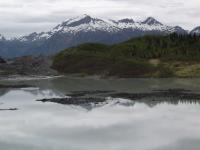
Primary succession following a receding glacier in Alaska. Whenever an event such as a fire, clear cut, or lava flow creates an empty habitat, species arrive, interact, and assemble to form a new ecological community—a process known as "succession." How quickly does succession proceed" Most ecologists might expect change to be rapid at first and then decline as the community ages, but there was no systematic analysis of this idea until recently.
In a study published in the June issue of the American Naturalist, ecologist Kristina Anderson of the University of New Mexico showed that in many communities—ranging from plants in abandoned agricultural fields to arthropods on carcasses—species do indeed turn over most rapidly early in succession, when many new species arrive to take advantage of available resources. However, she also found that certain adverse conditions—such as isolation of the new community or an unfavorable climate—may hinder the arrival of new species, thereby slowing the rate at which the community fills with species and sometimes causing peak rates of change to occur later in succession.
Anderson's study provides a framework to understand why communities mature at different rates. According to the author, "Understanding how quickly new ecological communities develop is fundamental to numerous ecological questions ranging from, 'How often should fires or clear cuts be allowed on landscapes"' to 'What determines how many species are found on an island"' yet we were unable to make many generalizations about succession rate. That is what motivated this study." In her study, Anderson first developed a method for quantifying rates of community change and how these vary as the community ages. She then collected data on over 60 different communities—a novel approach in succession research—and documented the changes in species composition throughout succession. Using these results, she was able to relate temporal patterns in rates of community change to processes that limit colonization and persistence of species: competition, harsh environmental conditions, and difficulty getting to the site. The author states, "We still have many unanswered questions regarding rates of succession. My hope is that this study will inspire and inform future research on succession rate."
Source : University of Chicago Press Journals
 Print Article
Print Article Mail to a Friend
Mail to a Friend
